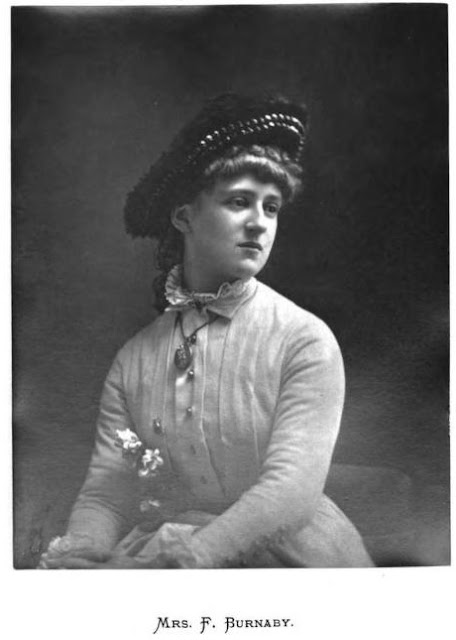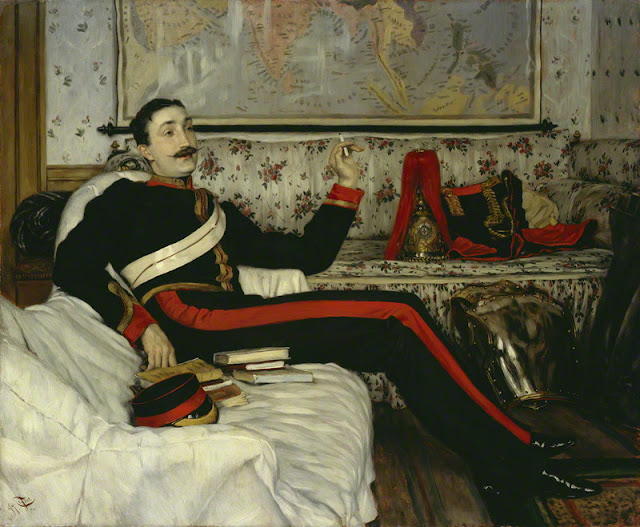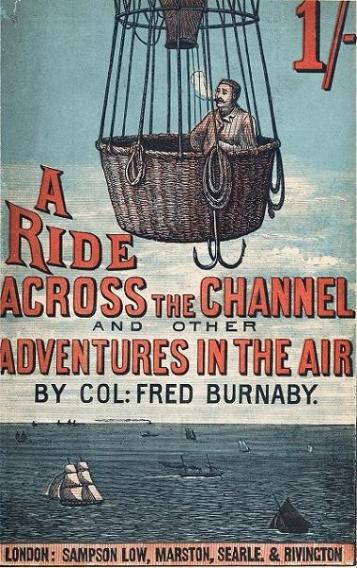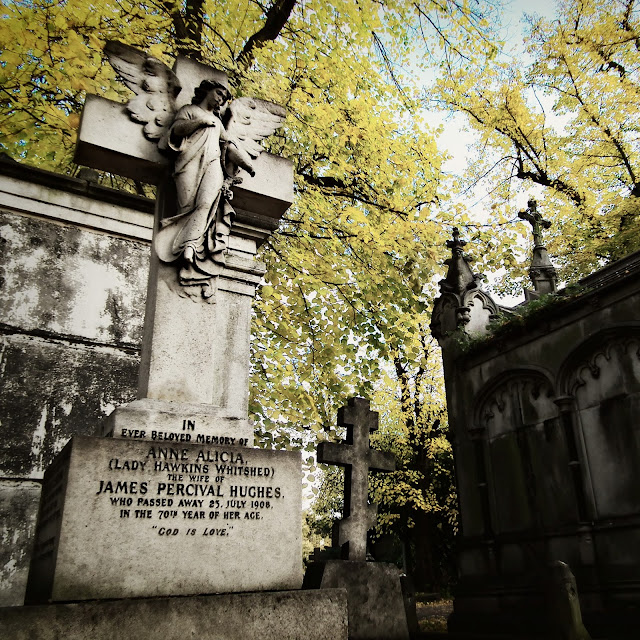Fred Burnaby was
often described as bohemian. His official biographer wrote that he lived
‘entirely aloof, absolutely regardless of conventionalities.’....Burnaby had
gone deep into Russia, across Asia Minor and the Middle East, up the Nile. He
had crossed Fashoda country, where both sexes went naked and dyed their hair
bright yellow. Stories that adhered to him often featured Circassian girls,
gypsy dancers and pretty Kirghiz widows.
He claimed
descent from Edward I, the king known as Longshanks, and displayed virtues of
courage and truth speaking which the English imagine unique to themselves. Yet
there was something unsettling about him. His father was said to be ‘melancholy
as the padge-owl that hooted in his park’, and Fred, though vigorous and extrovert,
inherited this trait. He was enormously strong, yet frequently ill, tormented
by liver and stomach pain, ‘gastric catarrh’ once drove him to a foreign spa.
And though ‘very popular in London and Paris’, and a member of the Prince of
Wales circle, He was described by the Dictionary of National Biography as
living ‘much alone’.
Julian Barnes
‘Levels of Life.’
It
was while I was reading Julian Barnes book a week ago that I decided that my
next subject for the London Dead would be Elizabeth Alice Frances Le
Blond. It may have been coincidence but
I suspect that unconsciously I recognised that there was a connection between
these two apparently unrelated individuals. Thrice married Lizze Le Blond had
been on my list of potential subjects for a very long time and I wasn’t sure
what had suddenly brought her to the forefront of my mind. I dug out the
photographs I had taken of her grave in Brompton Cemetery back on a beautiful cloudless
autumn day in 2013 and I started doing some basic research into her life. She was a woman of many achievements, the
least of which were her three marriages, but her first husband sounded like an
interesting character. I looked him up in the DNB but it was only when I read the
sentence “adventurous and excited by danger, Burnaby became an enthusiastic
balloonist....” that the penny finally dropped. ‘Levels of Life’ makes much of
the ballooning exploits of its characters and it was the aerial adventures of
Frederick Gustavus Burnaby that finally made me realise that this madcap Victorian
adventurer was Lizzie le Blond’s first husband. It is possible that was only a
coincidence but I think not; I’m convinced that Burnaby’s name, exploits and
wife were all stored somewhere in my brain but beyond the reach of conscious
recall and that apparently forgotten information prompted me to recall Lizzie. I
suspect my brains capacity to store information is still pretty good but my
ability to retrieve it is starting to deteriorate – if you can’t dig it out of
your memory it might as well not be in there in the first place. Anyway, I
suspect this is already going to be a hideously long post and I shouldn’t be
adding to it with these inconsequential rambles.

Frederick
Gustavus Burnaby was born in Rutland in 1842, the eldest son of a wealthy, fox
hunting parson who felt that two masters of foxhounds would make better
godparents for his offspring than any clerical colleagues. In the time honoured
traditions of the upper classes Fred spent most of his childhood at boarding
schools in England before going to Dresden to study languages (he eventually
spoke 7 fluently including Russian, Turkish and Arabic). At 16 his father
purchased him his first commission in the Royal Horse Guards (the Blues); he
became a cornet for a mere £1200. For his 18th birthday he was bought a
lieutenancy and when he was 23 he became a captain. He was a young man of
superior physical gifts, 6 feet 4 inches tall with a 46 inch chest, exceptional
strength, striking good looks but let down by a thin and piercing voice. His
obituaries describe a relatively short but exceptionally eventful life:
“Fred"
Burnaby was in many ways a remarkable man. His personal appearance, as he
sauntered down the street, or as he sat on horseback on parade, never failed to
attract attention. He was six feet four in height and burly to boot, with a dark,
finely cut, handsome face, and eyes ready enough to flash with the light of battle,
but equally ready and even more accustomed to turn upon a friend with kindliest
glance. In his youth he was passionately fond of gymnastics, in which he
excelled above all his fellows. There used to be in one of his clubs a colossal
dumb bell in a glass case, with the offer of a heavy wager that no man would
hold it out at arm’s length for the space of sixty seconds. The wager was never
won, though Burnaby made nothing of accomplishing the feat. Among the many
stories of his physical prowess one relates to a period shortly after he joined
the Blues. The regiment was down at Windsor, and a horse dealer who had come
into possession of couple of very small ponies had taken them thither by
command to exhibit them to the Queen. Before going to the Castle he showed them
to the officers of the Blues, to whom a happy thought occurred. Burnaby, who
was captain then, was in his own room on the first flight. With some trouble
the ponies were got upstairs, and, the door quietly opening, they trotted in
unannounced. This was a capital joke, and had great success. But, as presently
appeared, it had a gloomy side. The ponies had gone upstairs quietly enough;
but neither force nor entreaty could induce them to go down. The hour
approached at which they were to be presented the Queen, and the owner was in
despair. Burnaby settled the matter offhand.
Taking a pony up in either arm he walked down stairs and set them in the
courtyard.
Overtaxing even
his splendid physique by his untiring devotion to pursuits entailing such
muscular exertion, the late gallant officer had in early life to travel in
foreign lands to win back again the health he had lost. Entering the Horse
Guards Blue at eighteen, in the early years of his military career he had
travelled through South America and in Central Africa, and in 1875 he started
on his famous “Ride to Khiva,” which was attended with risks and difficulties
which would have overcome any but he. His intention to continue his journey to
Bokhara was frustrated by the Russian authorities at whose instigation the Duke
of Cambridge ordered his return from Central Asia. In the following year
Colonel Burnaby went on horseback through Asia Minor and Persia, and
subsequently he was a non-combatant and newspaper correspondent with Don
Carlos' army during the fighting in Spain. When the Soudan expedition from
Souakim against the Mahdi’s forces was
undertaken last year, Colonel Burnaby served under General Graham, bring
attached to the Intelligence Department, and be was present at the battle of El
Teb, where, it will be remembered, was the first to mount the parapet, and deal
destruction to the natives from his double-barrelled shotgun. Here a cannon
ball severely wounded the colonel the face, and he bad scarcely recovered from
the Injury sustained, when once again the restless voice of war called him out
to the land of the Nile, where was doomed to die.
 |
| The 28 year old Frederick Burnaby, 1870 portrait by James Jacques Tissot in the National Portrait Gallery |
In times of peace
his restless spirit sought fresh fields of peril, and was always going up in a
balloon. His last adventure In this direction was a little less than three
years ago, when he crossed the “silver streak” In the car of the Eclipse, and
after some vicissitudes In mid-air descended the Chateau de Montigny, near Envermeu, in Normandy. Colonel Burnaby took a keen
interest In politics, and at the general election of 1880 he contested
Birmingham in the Conservative interest, when, though unsuccessful, no fewer
than 15,710 votes were given in his favour. He was an excellent public speaker,
vigorous, concise, and pointed, with a rich fund of wit and humour, and had he
been spared would have made a good figure in Parliament.
One other
ambition he had beyond that of winning a seat at Birmingham. It was to visit
Timbuctoo and make the personal acquaintance of the King. This was the “next
trip” he had in his mind, and had he lived would probably have accomplished it,
for under his winning manner there was a resolute will that would have stopped at
nothing. But it has been finally stopped at Abu Klea.
Mid Sussex Times
- Tuesday 27 January 1885
 |
| A late Burnaby masterpiece detailing his aerial adventures |
Both
Julian Barnes and the obituaries fail to mention the fact that Burnaby was
married; in ‘Levels of Life’ Barnes ignores his genuine relationship with
Lizzie and instead concentrates on a completely concocted affair between the
explorer and the French actress Sarah Bernhardt. The newspapers had reported
extensively on Burnaby’s wedding in June 1879 but apart from mentioning that
the Queen had asked Sir Henry Fonsonby to telegraph her deep regrets to his
widow, said very little about her at his death. She was rather characteristically
staying at the Hotel Belvedere in Switzerland at the time and quite probably
consoled herself by climbing a mountain or two.
Elizabeth
Alice Frances Hawkins-Whitshed was the only daughter of a baronet and the
heiress to a substantial fortune which included an estate in County Wicklow in
Ireland. Her father died when she was eleven and even though her mother was
still alive she became a ward of chancery. Her time was split between the
family house in London and the Wicklow estate. Although there were no early
indications that she would be anything other than a conventional upper class
girl Frederick Burnaby presumably spotted something different about her when
she came out at her first London season, he praised her ‘piquant beauty, charm
of manner and intellectual gifts’. Lizzie was still 18 and technically a minor
which meant Fred had to seek the approval of the Lord Chancellor if he wanted
to marry her. In March 1879 the newspapers reported that the Chancellor “who is
slightly indisposed, sat on Saturday at his own house in Merrion Square,
Dublin, to approve of the heads of a settlement of an intended marriage between
Captain Burnaby, of "Khiva" notoriety, and Miss Whitshed (a minor and
ward court), the only child of the late Sir J. H, Whitshed, Bart.” The couple
were married 3 months later, on Wednesday 25th June, at St Peter’s, Brompton.
It was a glittering social affair with 400 guests, the Luton Times and
Advertiser described the bride as being “dressed in white satin trimmed with
Brussel’s point and fringes of orange blossoms, a wreath of orange blossoms,
and large tulle veil. Her ornaments were a diamond tiara, the gift of the
bridegroom, and a diamond bracelet and pendant, the gift of her mother.” The Leicester
Journal went on to describe how:
The Hon. Oliver
Montagu, son the Earl of Sandwich, officiated as best man. Mr. Arthur Bentinck
gave the bride away. The eight bridesmaids were Lady Madeleine Keith-Falconer,
Lady Blanche Keith-Falconer, Miss Felicia Bentinck, Miss Ottoline Bentinck,
Miss Renira Pollard, Miss May, Miss Erskine, and Miss Rita Handcock. The Hon
and' Rev. Arthur Byng, Chaplain to the House of Commons performed the ceremony,
in which was assisted by the Rev. Dr. Teignmouth Shore and the Rev. J. H.
Handcock, uncle of the bride. The register been duly inscribed, the wedding
party drove to Bailey's Hotel, Gloucester-road, where a sumptuous déjeuner à la
fourchette had been provided, and where Captain and Mrs. Burnaby subsequently
held reception... The company were received by
Captain and Mrs. Burnaby in the drawing room of the hotel—a very fine
apartment, furnished in blue and gold, and tastefully decorated with flowers
from the establishment of Mr. Aldous, F.R.H.S, the florist of' Gloucester-road.
Both here and in the coffee-room, where the déjeuner was spread, flowers were
profusely used in the decorations, the walls bearing medallions of flowers at
regular intervals; and a floral wedding bell depended from the centre-piece of
the ceiling. On the staircases of the hotel were also placed choice flowers and
evergreens, which loaded the air with perfume and added to the brilliancy of the
scene. After the reception Captain and Mrs. Burnaby left for the Continent,
where they are going to spend their honeymoon. Among a large number of valuable
presents which were displayed in the drawing room of Bailey's Hotel, were a
smoking room service, Japanese manufacture, in blue and gold enamel, given by
the Prince of Wales.....
Although
we know, courtesy of the newspapers, exactly what Lizzie was wearing when she
set off on honeymoon (‘The bride’s travelling dress was stone-coloured
cashmere, trimmed with satin to match, a white chip bonnet, and long white
feather’), the only thing we know about the honeymoon itself is that Lizzie
came back pregnant and the couple were barely on speaking terms. They lived in
London, together, until the birth of their only child, a boy, but before they
could celebrate their first wedding anniversary Lizzie had moved to Switzerland
‘for the sake of her health.’ The presumptive consumptive startled everyone by
taking up mountain climbing, something almost unheard for a woman in the dying
years of the Victorian age. The cosseted ward of the Chancellor discovered
unimagined freedom in the mountains, including the hitherto novel experience of
putting “on my own boots, and I was none too sure on which foot should go which
boot. It is difficult for me to realize now that for several years longer it
did not occur to me that I could do without a maid … I owe a supreme debt of gratitude
to the mountains for knocking from me the shackles of conventionality, but I
had to struggle hard for my freedom. My mother faced the music on my behalf
when my grand-aunt, Lady Bentinck, sent out a frantic S.O.S. ‘Stop her climbing
mountains! She is scandalizing all London and looks like a Red Indian.’” As well as being sunburnt Lizzie climbed in
pragmatic short skirts which barely came down to her knees, to her scandalised
contemporaries, practically naked in other words. Perhaps in competition with
Fred who had turned out a couple of bestsellers about his travels and his
ballooning, within a couple of years she
had written her first book “The High Alps in Winter or Mountaineering in Search
of Health.” She went on to write many more.
 |
| Lizzie and companion in formal mountaineering attire c1890 |
In
his wife’s absence Fred took up politics, running unsuccessfully for Birmingham
as an MP in 1880, and hot air ballooning, making his first aerial channel
crossing in 1882. The onset of middle age and the more sedentary lifestyle
began to take a toll on his legendary strength and stamina and his good looks
spoiled as he gained weight. He was keen to see active service and was
disappointed when his services were declined for the 1882 Egyptian Campaign. He
had better luck in 1884 when he persuaded his friend General Baker to take him
to the Sudan as an intelligence officer. He courted disapproval at the second
battle of El Teb in February by using a double barrelled shotgun to fight the
Mahdists but was wounded and invalided back to London. In England he had fallen
out of favour with the Prince of Wales and quarrelled with his superior
officers. He was desperate to join the Gordon Relief Expedition and return to
the Sudan but permission was refused. Unluckily he knew General Wolseley the
leader of the expedition, who thought him ‘clever and as brave as a lion’ and
allowed him to join as a volunteer. He left for Eygpt in November 1884 and died
at the battle of Abu Klea on 17 January 1885. Some say his orders led to the
breaking of the British Square at the battle, only the second time this had
happened during Victoria’s reign. If this is true he paid a heavy price; surrounded
by Mahdists and fighting them off with his sabre he was speared in the throat
and then hacked down by their swords. A private who went to his rescue received
a DCM but Burnaby received nothing – Wolseley wrote cruelly ‘how delighted the
Prince of Wales & the Duke of Cambridge will be that poor Burnaby is killed.’
Queen Victoria is said to have fainted when she heard the news. Lizzie simply
said ‘he died as he would have wished, facing the foe’ and left it at that.
Fred was buried on the battle field along with the other British dead, “Fred
Burnaby sleeps in a soldier’s grave in the continent whose inmost recesses he
had quietly arranged with himself would someday explore,” as the Mid Sussex
Times put it.
 |
| The death of Colonel Burnaby - the moment just before a Mahdist buries his spear in Fred's neck |
Lizzie
continued to spend most of her time in Switzerland, climbing, taking an active
interest in winter sports (she was the first woman to pass the men’s ice
skating test), taking bicycle trips through the Alps and raced motor cars in
hill climbing contests. She also trained herself to become an accomplished
photographer (she was a medalist of the Royal Photographic Society). She
became one of the first women to take up film making, a 1902 catalogue lists 10
of her short films, all shot in Switzerland. Despite her disillusioning
experiences of marriage and the tragic death of her husband, Lizzie apparently
remained an optimist about matrimony. In Switzerland she met John Frederic
Main, a professor of engineering at Bristol University, who was staying in
Davos to recuperate from a severe pulmonary attack. Following what must have
been a whirlwind romance she married him in 1886. Her lucky husband became the
recipient of a £1000 a year marriage settlement from his wife’s Irish estates
but it wasn’t enough to make him stay with her. After just a year of conjugal
cohabitation Main left Lizzie in Switzerland and took off for the United States
where he lived in Denver, on Lizzie’s money, until his death in 1892. Once shy,
twice bitten Lizzie did not marry again until 1900; her last husband was
Francis Aubrey Le Blond of Aldeburgh in Suffolk, nine years her junior. The
wedding was rather less lavish than her first to Fred but still made the
society pages of the newspapers, as this extract from the Morning Post of 14
June 1900 shows:

The marriage of
Francis Bernard Aubrey Le Blond, eldest son of Francis Aubrey Le Blond, of
Norbiton, Surrey, to Elizabeth Alice Frances Main, only child of the late Sir
St. Vincent Bentinck Hawkins Whitshed, Bart., of Killincarrick, County Wicklow,
Ireland, took place at St. Mary Abbot's, Kensington, on Tuesday. The wedding
was very quiet, only the nearest relatives of the bride and bridegroom being present.
The officiating clergymen were the vicar, the Rev. Canon Pennefather, and the
Rev. W. Pace Rigg, M.A., uncle of the bridegroom. At the conclusion of the
ceremony Mr. and Mrs. Aubrey Le Blond left town, en route for Norway.
Norway
was where Lizzie now preferred to do her climbing following a fatal accident in
the Alps that killed the son of her guide. Aubrey seemed content to let his
wife carry on climbing; he was more interested in collecting oriental pottery
(his Korean collection was eventually donated to the Victoria and Albert
Museum) In comparison to her previous marriages this final trip to the altar
was followed by wedded bliss. She continued to lead an independent life but
often travelled with her husband, going with him to China, Korea and Japan in
1912, and riding the Tran-Siberian railway to Russia back in 1913. She wrote
more books, took more photographs and climbed more mountains. In the First
World War she volunteered at a hospital in Dieppe, raised funds for ambulances
and after the Armistice founded a fund for the restoration of war damaged
Rheims Cathedral. After the war she travelled to Morocco and the United States
and was awarded the Légion d'honneur for her efforts in getting a statue of
Marshall Foch erected in London. She died on 27 July 1934.whilst recovering
from a major operation at Mangalore, the home of her brother-in-law, Dr George
Worthington, in Llandrindod Wells, Radnorshire. She was buried with her mother
in Brompton Cemetery in the family vault, which occupies a large plot next to
the McDonald Mausoleum. For such a large and expensive plot the family memorial
is relatively modest and unobtrusive.



















